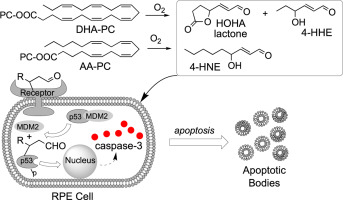当前位置:
X-MOL 学术
›
Free Radical Bio. Med.
›
论文详情
Our official English website, www.x-mol.net, welcomes your feedback! (Note: you will need to create a separate account there.)
4-Hydroxy-7-oxo-5-heptenoic acid (HOHA) lactone induces apoptosis in retinal pigment epithelial cells.
Free Radical Biology and Medicine ( IF 7.4 ) Pub Date : 2020-03-25 , DOI: 10.1016/j.freeradbiomed.2020.03.017 Mikhail Linetsky 1 , Junhong Guo 2 , Emeka Udeigwe 2 , Duoming Ma 2 , Amanda S Chamberlain 3 , Annabelle O Yu 4 , Kseniya Solovyova 5 , Elise Edgar 2 , Robert G Salomon 1
Free Radical Biology and Medicine ( IF 7.4 ) Pub Date : 2020-03-25 , DOI: 10.1016/j.freeradbiomed.2020.03.017 Mikhail Linetsky 1 , Junhong Guo 2 , Emeka Udeigwe 2 , Duoming Ma 2 , Amanda S Chamberlain 3 , Annabelle O Yu 4 , Kseniya Solovyova 5 , Elise Edgar 2 , Robert G Salomon 1
Affiliation

|
Retinal pigment epithelial (RPE) cell dysfunction and death play vital roles in age-related macular degeneration (AMD) pathogenesis. Previously we showed that oxidative cleavage of docosahexenoate (DHA) phospholipids generates an α,β-unsaturated aldehyde, 4-hydroxy-7-oxohept-4-enoic acid (HOHA) lactone, that forms ω-carboxyethylpyrrole (CEP) derivatives through adduction to proteins and ethanolamine phospholipids. CEP derivatives and autoantibodies accumulate in the retinas and blood plasma of individuals with AMD and are a biomarker of AMD. They promote the choroidal neovascularization of "wet AMD". Immunization of mice with CEP-modified mouse serum albumin induces "dry AMD"-like lesions in their retinas as well as interferon-gamma and interleukin-17 production by CEP-specific T cells that promote inflammatory M1 polarization of macrophages. The present study confirms that oxidative stress or inflammatory stimulus produces CEP in both the primary human ARPE-19 cell line and hRPE cells. Exposure of these cells to HOHA lactone fosters production of reactive oxygen species. Thus, HOHA lactone participates in a vicious cycle, promoting intracellular oxidative stress leading to oxidative cleavage of DHA to produce more HOHA lactone. We now show that HOHA lactone is cytotoxic, inducing apoptotic cell death through activation of the intrinsic pathway. This suggests that therapeutic interventions targeting HOHA lactone-induced apoptosis may prevent the loss of RPE cells during the early phase of AMD. We also discovered that ARPE-19 cells are more susceptible than hRPE cells to HOHA lactone cytotoxicity. This is consistent with the view that, compared to normal RPE cells, ARPE-19 cells exhibit a diseased RPE phenotype that also includes elevated expression of the mesenchymal indicator vimentin, elevated integrin a5 promotor strength and deficient secretion of the anti-VEGF molecule pigment-epithelium-derived factor fostering weaker tight junctions.
中文翻译:

4-羟基-7-氧代-5-庚烯酸(HOHA)内酯诱导视网膜色素上皮细胞凋亡。
视网膜色素上皮(RPE)细胞功能障碍和死亡在与年龄有关的黄斑变性(AMD)发病机理中起着至关重要的作用。以前我们证明了二十二碳六烯酸酯(DHA)磷脂的氧化裂解会生成α,β-不饱和醛,4-羟基-7-氧杂-4-烯酸(HOHA)内酯,该内酯通过加成生成ω-羧乙基吡咯(CEP)衍生物蛋白和乙醇胺磷脂。CEP衍生物和自身抗体积聚在患有AMD的个体的视网膜和血浆中,并且是AMD的生物标记。它们促进“湿性AMD”的脉络膜新血管形成。CEP修饰的小鼠血清白蛋白对小鼠的免疫诱导“干性AMD” CEP特异的T细胞促进视网膜巨噬细胞的炎症性M1极化,在视网膜上产生类似的病变,以及干扰素-γ和白介素17的产生。本研究证实,氧化应激或炎性刺激在原代人ARPE-19细胞系和hRPE细胞中均产生CEP。将这些细胞暴露于HOHA内酯可促进产生活性氧。因此,HOHA内酯参与恶性循环,促进细胞内氧化应激,导致DHA的氧化裂解,从而产生更多的HOHA内酯。现在我们显示,HOHA内酯具有细胞毒性,可通过激活内在途径来诱导凋亡性细胞死亡。这表明靶向HOHA内酯诱导的细胞凋亡的治疗性干预措施可以防止RPE细胞在AMD早期丢失。我们还发现ARPE-19细胞比hRPE细胞更容易受到HOHA内酯的细胞毒性作用。这与以下观点一致:与正常RPE细胞相比,ARPE-19细胞表现出患病的RPE表型,其中还包括间充质指示波形蛋白的表达升高,整联蛋白a5启动子强度升高以及抗VEGF分子色素-分泌不足。上皮衍生因子促进较弱的紧密连接。
更新日期:2020-03-26
中文翻译:

4-羟基-7-氧代-5-庚烯酸(HOHA)内酯诱导视网膜色素上皮细胞凋亡。
视网膜色素上皮(RPE)细胞功能障碍和死亡在与年龄有关的黄斑变性(AMD)发病机理中起着至关重要的作用。以前我们证明了二十二碳六烯酸酯(DHA)磷脂的氧化裂解会生成α,β-不饱和醛,4-羟基-7-氧杂-4-烯酸(HOHA)内酯,该内酯通过加成生成ω-羧乙基吡咯(CEP)衍生物蛋白和乙醇胺磷脂。CEP衍生物和自身抗体积聚在患有AMD的个体的视网膜和血浆中,并且是AMD的生物标记。它们促进“湿性AMD”的脉络膜新血管形成。CEP修饰的小鼠血清白蛋白对小鼠的免疫诱导“干性AMD” CEP特异的T细胞促进视网膜巨噬细胞的炎症性M1极化,在视网膜上产生类似的病变,以及干扰素-γ和白介素17的产生。本研究证实,氧化应激或炎性刺激在原代人ARPE-19细胞系和hRPE细胞中均产生CEP。将这些细胞暴露于HOHA内酯可促进产生活性氧。因此,HOHA内酯参与恶性循环,促进细胞内氧化应激,导致DHA的氧化裂解,从而产生更多的HOHA内酯。现在我们显示,HOHA内酯具有细胞毒性,可通过激活内在途径来诱导凋亡性细胞死亡。这表明靶向HOHA内酯诱导的细胞凋亡的治疗性干预措施可以防止RPE细胞在AMD早期丢失。我们还发现ARPE-19细胞比hRPE细胞更容易受到HOHA内酯的细胞毒性作用。这与以下观点一致:与正常RPE细胞相比,ARPE-19细胞表现出患病的RPE表型,其中还包括间充质指示波形蛋白的表达升高,整联蛋白a5启动子强度升高以及抗VEGF分子色素-分泌不足。上皮衍生因子促进较弱的紧密连接。


























 京公网安备 11010802027423号
京公网安备 11010802027423号